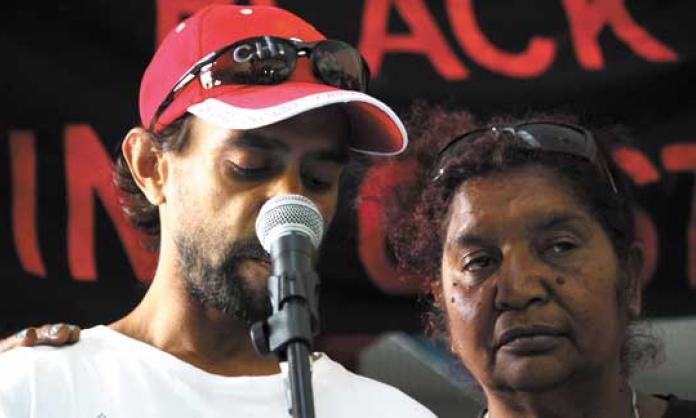Eddie Murray was snatched off the main street of Wee Waa, a small cotton-growing town in north-west NSW, at 2:00pm on 12 June 1981. Witnesses say that the police came only for him. “Come on Eddie Murray, we want you, Come on Eddie Murray, we want you”, the officers were heard singing to their 21-year-old target, who was standing with friends.
Minutes later, he disappeared into the back of the police wagon, detained under the Intoxicated Persons Act – for his own safety. From there, what was left of a life can be counted in minutes; not more than 60 and in all likelihood a great many fewer.
Before his family even knew he had been picked up, Eddie was gone. A little after 3:30pm, the first born child of Arthur and Leila Murray was delivered to the morgue at the Wee Waa district hospital. No longer Eddie, now just “a police body”, according to hospital CEO Albert Sharples’ evidence at an inquest months later. Not Eddie who was cheeky and a champion rugby player. Not Eddie who could fish all day and who stood up for himself. Not Eddie, who, like his parents, talked openly about the discrimination experienced by Aboriginal people in Wee Waa.
Explaining why, despite a summons, he could not produce a single note or record of an Edward James Murray being brought to his hospital, Sharples told the coroner that the hospital had no need to make a record. The nameless black body taken to the hospital morgue on 12 June 1981 “belonged to the police”, he said.
They had come only for Eddie that day. And they got him.
Nearly 34 years later, the Murray family still don’t know what happened. The only people who do have never told the truth about it. They say he hung himself in cell one of the Wee Waa police station. They say that, despite his state of acute intoxication (6 times the legal driving limit), he tore with bare hands a lengthways strip from the government-issue grey woollen blanket in his cell, carefully folded the strip along its whole length, balanced on tip toes and with outstretched arms threaded it around a bar in grille nearly 50cm above his head, deftly avoiding the grille’s close mesh backing; that he then fashioned a perfect noose and strangled himself with his feet touching the ground.
“I know he couldn’t have, he wouldn’t have”, says Anna Murray, talking through tears about her brother. As a 16 year old she said the same thing to the Wee Waa police when they showed her and others in the family to the cell where they say Eddie had hanged himself the day before.
Like the rest of the family, Anna has never believed that he committed suicide. “There’s no way”, she says. “Every time I talk about things it makes me cry, but it needs to be told.” Telling Eddie’s story is what the Murray family have done for more than three decades. “Tell you the truth, I think about it every day”, Anna says. “At night I see him laying in the morgue. I can see his face, see it clearly.”
The coroner in Eddie’s case heard “no evidence on which to be satisfied that the deceased committed suicide”. He labelled crucial parts of the police version of events “unreliable” and their investigation inadequate. Yet, in a determination that jars devastatingly with the evidence, he found no one to blame for the sudden death of the young man the police regarded a “troublemaker”.
The open coronial finding of 18 December 1981 remains the official account of the manner and circumstances of Eddie Murray’s death. Whether he died “by his own hand or the hand of person or persons unknown” the coroner would not say.
“Person or persons unknown.” Anna repeats the words like she’s said them a thousand times before. “I want the police to be charged, they gotta be charged”, she says. “I want people to bring back the things that they stole from our family.” The injustice of Eddie’s case is no less painful today than in the past.
Today is a sticky December day in Sydney. At the Settlement, a neighbourhood centre in Redfern, the Indigenous Social Justice Association has called a meeting to talk about Black deaths in custody. “They can’t go out and directly shoot us now, as they once did, but they’re still killing us”, says Ray Jackson, who chairs the meeting and is president of ISJA. “The trauma, the destruction of these families occurs only because of the injustice in this country.”
“Honestly, I don’t know how they sleep at night, the powers-that-be”, Marcia Mason Hoskins tells the forum. Four years ago in Collarenebri, NSW, her brother Mark Mason was shot dead by police as five of them surrounded him during an attempted arrest. He had no gun. The coroner found that the police acted in self defence. “They call it reasonable. We call it murder.”
More than 50 people sit through the afternoon heat listening to the families speak. Theirs is a group that grows every year. Black deaths in custody are on the rise again. The Australian Institute of Criminology, which regularly compiles a report on the topic, found that 2009-2010 was equal with the worst year on record for Aboriginal deaths in prison.
In the 20 years since the Royal Commission into Aboriginal Deaths in Custody recommended prison be a measure of last resort, the rate at which Aboriginal people are imprisoned has doubled. Since 1991, when the commission handed down its 339 recommendations, 340 Aboriginal people have died in custody, according to the government’s own figures. Activists say this is likely an under-estimation because it ignores deaths occurring in other institutions of state control, such as psychiatric facilities.
There is no mercy shown the young either. An investigation by the Australian Institute of Health and Welfare reported that, on any given night in 2014, more than 50 percent of the youth detention population was Aboriginal or Torres Strait Islander. In Western Australia, this figure rose to nearly three-quarters and in the Northern Territory to 90 percent.
Sentencing practices in north-west NSW stand out. According to state government figures, from the start of 2007 to the middle of 2012, 245 Indigenous youth (under 18) were given a prison sentence or put under a control order. Only 14 non-Indigenous youth received the same penalties.
A few weeks ago Shaun Harris took his first ever plane trip, leaving Western Australia for the east coast. After the August death of his niece, 22-year-old Ms Dhu, who was being held at the South Hedland police station, Harris joined the campaign against deaths in custody. “We’ve got to stand together to fight this because the sheer scope of it is massive”, he said after the forum.“If I have to travel right across the country to spread the word, tell the truth, I will.”
No one has yet said how Ms Dhu died. There is no question that her death was painful. An autopsy found that she had a head injury, fractured ribs and blood on her lungs. Her mouth, nose and body were covered in vomit. Witnesses reported hearing her crying in pain in her cell. She was twice taken to the South Hedland medical campus and twice returned to the watch house without seeing a doctor.
Ms Dhu had been arrested and jailed over an unpaid fine, a practice that has since been stridently defended by the Western Australian attorney general. “Unpaid fines. To lose her life over that is a testament to how deeply ingrained the racism is in the system”, Shaun says.
“We’ve had enough of the mistreatment of our people. There’s been no accountability – ever. With my niece, the police, the government and the health system need to be held accountable.”
Shaun gets most animated when talking about what needs to happen. For his family, he wants answers and “justice, full stop”. And he wants the deaths to stop. “Start implementing the damn [royal commission] recommendations. There’s been a 150 percent increase in deaths since the Royal Commission – that’s not getting better, that’s getting worse.”
For Shaun, this is the start of a “very long road.” Already he’s organised a national day of action against deaths in custody. He says he will keep fighting. “We’re all in this together, we need to stand as one and achieve something.”









